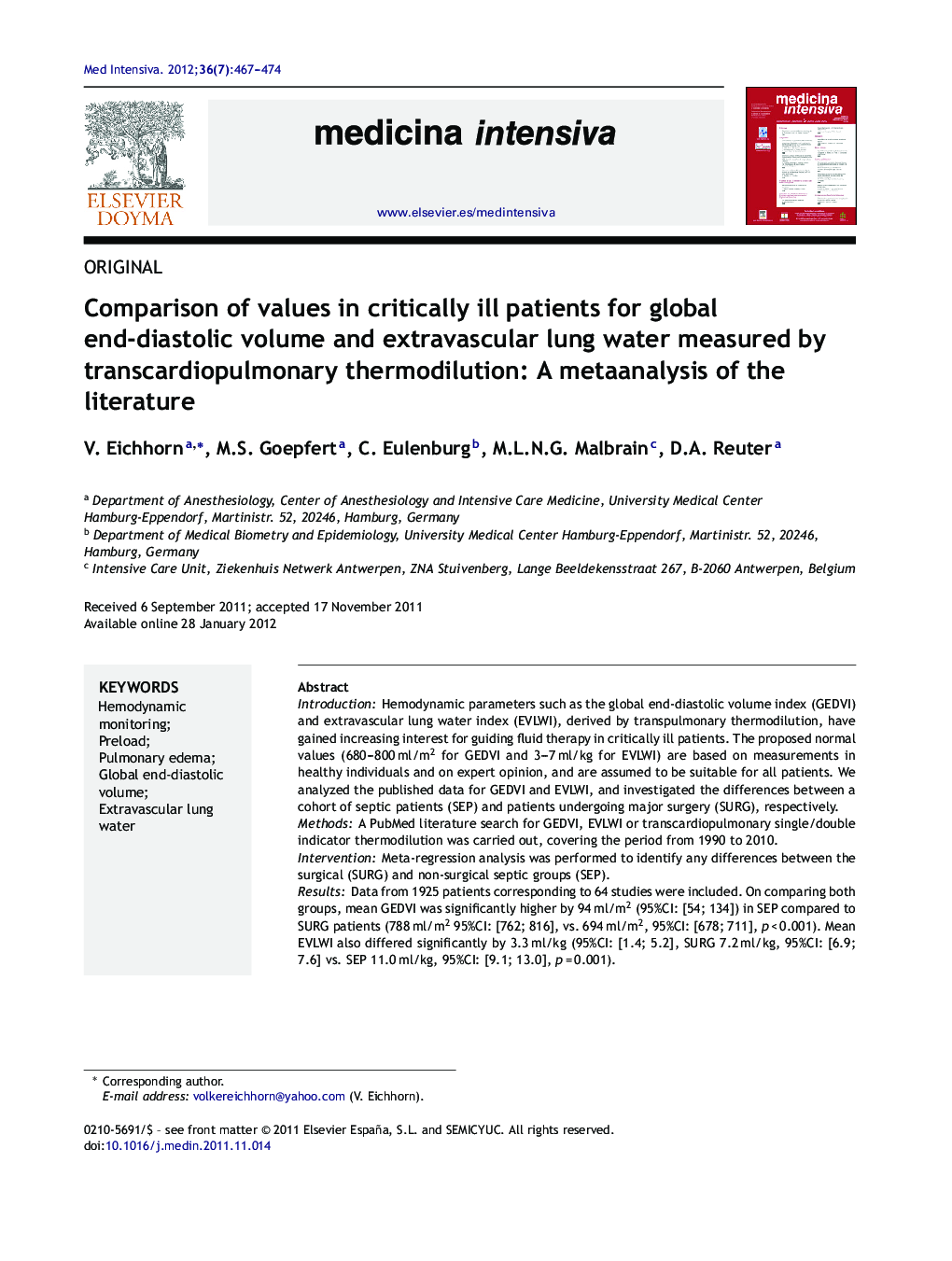| کد مقاله | کد نشریه | سال انتشار | مقاله انگلیسی | نسخه تمام متن |
|---|---|---|---|---|
| 3112783 | 1192336 | 2012 | 8 صفحه PDF | دانلود رایگان |

IntroductionHemodynamic parameters such as the global end-diastolic volume index (GEDVI) and extravascular lung water index (EVLWI), derived by transpulmonary thermodilution, have gained increasing interest for guiding fluid therapy in critically ill patients. The proposed normal values (680–800 ml/m2 for GEDVI and 3–7 ml/kg for EVLWI) are based on measurements in healthy individuals and on expert opinion, and are assumed to be suitable for all patients. We analyzed the published data for GEDVI and EVLWI, and investigated the differences between a cohort of septic patients (SEP) and patients undergoing major surgery (SURG), respectively.MethodsA PubMed literature search for GEDVI, EVLWI or transcardiopulmonary single/double indicator thermodilution was carried out, covering the period from 1990 to 2010.InterventionMeta-regression analysis was performed to identify any differences between the surgical (SURG) and non-surgical septic groups (SEP).ResultsData from 1925 patients corresponding to 64 studies were included. On comparing both groups, mean GEDVI was significantly higher by 94 ml/m2 (95%CI: [54; 134]) in SEP compared to SURG patients (788 ml/m2 95%CI: [762; 816], vs. 694 ml/m2, 95%CI: [678; 711], p < 0.001). Mean EVLWI also differed significantly by 3.3 ml/kg (95%CI: [1.4; 5.2], SURG 7.2 ml/kg, 95%CI: [6.9; 7.6] vs. SEP 11.0 ml/kg, 95%CI: [9.1; 13.0], p = 0.001).ConclusionsThe published data for GEDVI and EVLWI are heterogeneous, particularly in critically ill patients, and often exceed the proposed normal values derived from healthy individuals. In the group of septic patients, GEDVI and EVLWI were significantly higher than in the group of patients undergoing major surgery. This points to the need for defining different therapeutic targets for different patient populations.
ResumenIntroducciónParámetros hemodinámicos como el índice de volumen diastólico final global (GEDVI) y el índice de agua pulmonar extravascular (EVLWI), obtenidos mediante termodilución transpulmonar, suscitan un interés creciente como guía de la terapia de fluidos en pacientes críticamente enfermos. Los valores normales propuestos (680–800 ml/m2 para el GEDVI y 3-7 ml/kg para el EVLWI) se basan en mediciones realizadas a individuos sanos y en la opinión de expertos, y se asume que son adecuados para todos los pacientes. Analizamos los datos publicados sobre el GEDVI y el EVLWI e investigamos las diferencias entre una cohorte de pacientes septicémicos (SEP) y pacientes sometidos a cirugía mayor (SURG) respectivamente.MétodosSe realizó una búsqueda bibliográfica en PubMed de GEDVI, EVLWI o termodilución trasncardiopulmonar de indicador único/doble referida al periodo comprendido entre 1990 y 2010.IntervencionesSe realizó un análisis de metarregresión para identificar las diferencias entre los grupos quirúrgico (SURG) y no quirúrgico septicémico (SEP).ResultadosSe incluyeron los datos de 1925 pacientes correspondientes a 64 estudios. Al comparar ambos grupos, el GEDVI medio resultó ser significativamente mayor, con un aumento de 94 ml/m2 (IC del 95 %: [54; 134]) en el grupo SEP en comparación con los pacientes SURG (788 ml/m2, IC del 95 %: [762; 816], frente a 694 ml/m2, IC del 95 %: [678; 711], p<0,001). El EVLWI medio también presentó una diferencia significativa de 3,3 ml/kg (IC del 95 %: [1,4; 5,2], SURG 7,2 ml/kg, IC del 95 %: [6,9; 7,6] frente a SEP 11,0 ml/kg, IC del 95 %: [9,1;13,0], p=0,001).ConclusionesLos datos publicados del GEDVI y el EVLWI son heterogéneos, especialmente en pacientes críticamente enfermos, y a menudo superan los valores normales propuestos a partir de individuos sanos. En el grupo de pacientes septicémicos, los índices GEDVI y EVLWI fueron significativamente más altos que en el grupo de pacientes sometido a cirugía mayor. Esto pone de manifiesto la necesidad de definir distintos objetivos terapéuticos para las distintas poblaciones de sujetos.
Journal: Medicina Intensiva - Volume 36, Issue 7, October 2012, Pages 467–474